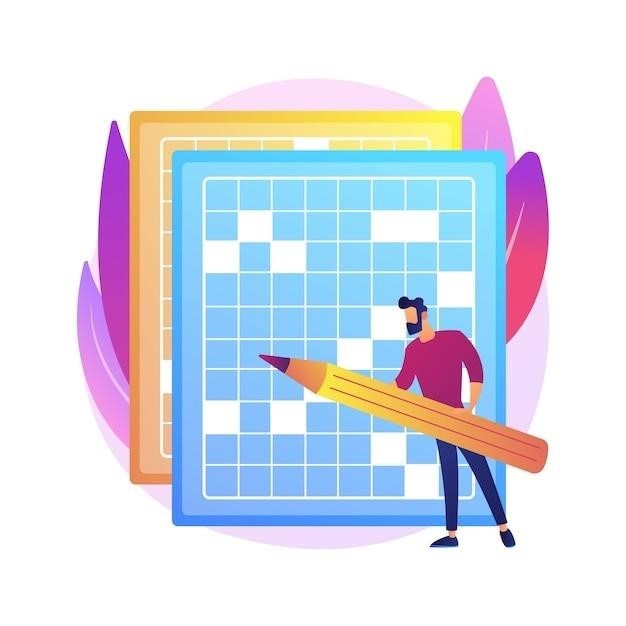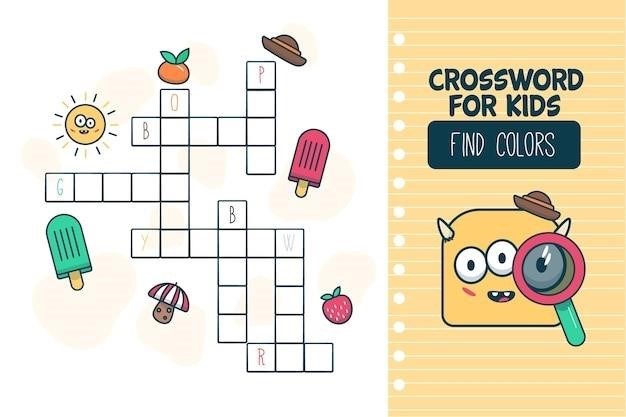Instructional Crossword⁚ A Powerful Tool for Learning
Instructional crosswords are a fun and engaging way to learn new information․ They can be used to reinforce vocabulary, concepts, and facts across a variety of subjects․ By combining the challenge of a crossword puzzle with the educational value of learning new material, instructional crosswords can be a powerful tool for students of all ages․
Introduction
In the realm of educational tools, instructional crosswords stand out as a unique and engaging approach to learning․ These word puzzles, designed to reinforce academic concepts and vocabulary, have proven to be a valuable asset in classrooms and beyond․ The appeal lies in their ability to blend the inherent enjoyment of solving crosswords with the acquisition of knowledge․ Instructional crosswords provide a stimulating and interactive platform for students to delve into subject matter, strengthening their comprehension and retention in a way that traditional methods often struggle to achieve․
The effectiveness of instructional crosswords stems from their ability to engage multiple cognitive processes․ Solving a crossword puzzle requires students to think critically, analyze clues, and draw connections between words and concepts․ This multifaceted approach fosters a deeper understanding of the subject matter than simply reading or memorizing facts․ Furthermore, the visual nature of crosswords can enhance visual learners’ engagement and retention․
From elementary school to higher education, instructional crosswords have found a place in diverse learning environments․ They serve as a valuable tool for teachers seeking to enhance their lessons, provide supplementary learning opportunities, and foster a more engaging and enjoyable learning experience for students․ The versatility of instructional crosswords allows them to be adapted to various subjects, making them a truly adaptable and valuable resource in the educational landscape․
Types of Instructional Crosswords
Instructional crosswords come in a variety of formats, each tailored to specific learning objectives and student needs․ Here are some common types⁚
- Vocabulary Crosswords⁚ These crosswords focus on building vocabulary by providing definitions, synonyms, or antonyms as clues․ They are particularly useful for language arts and foreign language instruction․
- Concept Crosswords⁚ These crosswords emphasize understanding key concepts within a subject․ Clues might involve definitions, examples, or applications of the concept․ They are effective for subjects like science, history, and mathematics․
- Fact-Based Crosswords⁚ These crosswords test knowledge of specific facts, dates, or events․ They can be used for any subject that involves memorization of information․
- Picture Crosswords⁚ These crosswords use images as clues, requiring students to identify the related vocabulary or concepts․ They are particularly engaging for visual learners and can be adapted to various subjects․
- Themed Crosswords⁚ These crosswords focus on a specific theme or topic, such as a historical event, a literary work, or a scientific discovery․ They provide a structured way to explore a particular area of study․

The choice of crossword type depends on the learning objectives and the age and abilities of the students․ Teachers can select the format that best suits their lesson plans and individual student needs․

Benefits of Using Instructional Crosswords
Instructional crosswords offer a wealth of benefits for students and educators alike․ Their unique combination of wordplay and learning makes them an engaging and effective tool for various educational settings․ Here are some key benefits⁚
- Enhanced Vocabulary⁚ Crosswords help students expand their vocabulary by exposing them to new words and their definitions․ The act of deciphering clues encourages students to think about word relationships and context․
- Improved Comprehension⁚ Solving crossword puzzles requires students to analyze clues and connect them to related concepts, which strengthens comprehension skills․ It encourages them to think critically and make inferences․
- Increased Engagement⁚ The puzzle format of crosswords is inherently engaging, making learning more enjoyable and less daunting for students․ This can lead to increased motivation and participation in the learning process․
- Reinforced Memory⁚ The act of retrieving information from memory to solve a crossword puzzle strengthens the memorization process․ It encourages students to recall previously learned facts and concepts․
- Development of Critical Thinking Skills⁚ Crosswords challenge students to think logically and strategically, fostering critical thinking skills․ They must consider various possibilities, evaluate clues, and make deductions to arrive at the correct answer․
- Collaborative Learning⁚ Crosswords can be used as a collaborative activity, encouraging teamwork and communication among students․ They can work together to solve clues, share ideas, and learn from each other․
Overall, instructional crosswords provide a fun and effective way to enhance vocabulary, improve comprehension, increase engagement, reinforce memory, and develop critical thinking skills․ Their versatility makes them suitable for a wide range of subjects and learning styles, making them a valuable tool for educators at all levels․
Creating Instructional Crosswords
Creating instructional crosswords is a rewarding process that allows educators to tailor learning experiences to their students’ specific needs․ Here’s a step-by-step guide to crafting effective crosswords⁚
- Define Your Learning Objectives⁚ Clearly identify the vocabulary, concepts, or facts you want students to learn or reinforce․ The crossword should be designed to directly address these objectives․
- Choose a Theme⁚ Selecting a theme can make the crossword more engaging and relevant to your students․ This could be a specific topic, historical event, literary work, or even a current event․
- Select Your Words⁚ Choose a set of words related to your theme and learning objectives․ Ensure the words are appropriate for your students’ age and vocabulary level․
- Create the Grid⁚ Draw a grid with enough squares to accommodate your chosen words․ The size of the grid will depend on the number of words and their lengths․
- Write the Clues⁚ Craft clues for each word that are clear, concise, and challenging enough to stimulate thinking․ Clues can be definitions, synonyms, examples, or even riddles․
- Test Your Crossword⁚ Before presenting the crossword to students, solve it yourself to ensure the clues are accurate and the puzzle is solvable․ Consider asking a colleague or another educator to test it as well․
- Provide a Solution⁚ Always provide a solution key for students to check their answers and reinforce their learning․
With a little creativity and planning, educators can create engaging and effective instructional crosswords that make learning more enjoyable and memorable for their students․
Tips for Solving Instructional Crosswords
Solving instructional crosswords can be a rewarding challenge, enhancing vocabulary and critical thinking skills․ Here are some tips to help you conquer those puzzles⁚
- Read the Clues Carefully⁚ Pay close attention to the wording of each clue․ Look for key words like synonyms, antonyms, or examples that might provide hints․
- Start with the Easy Clues⁚ Begin with the clues that seem the most straightforward or that you feel confident about answering․ This can help get you started and build momentum․
- Look for Intersections⁚ As you solve clues, pay attention to where the words intersect on the grid․ These intersections can provide valuable clues for other words, especially if you already know some letters․
- Consider Word Lengths⁚ The length of the word indicated by the clue can provide valuable information․ If a clue calls for a five-letter word, you can eliminate any words that don’t fit that length․
- Think Outside the Box⁚ Don’t be afraid to try different approaches and consider multiple possibilities․ Sometimes, a clue might have more than one possible answer, so be open to exploring different options․
- Don’t Be Afraid to Ask for Help⁚ If you’re stuck on a clue, don’t hesitate to ask your teacher or a classmate for assistance․ They might be able to offer a hint or a new perspective that helps you solve the puzzle․
Remember, solving instructional crosswords is a learning experience, so don’t be discouraged if you encounter difficulties․ Persistence and a willingness to try different approaches will lead you to success․
Instructional Crosswords in the Classroom
Instructional crosswords can be a valuable addition to any classroom curriculum, offering a fun and engaging way for students to learn and review material․ They can be incorporated into various subject areas, from language arts and science to history and mathematics․ Here are some ways to use instructional crosswords in the classroom⁚
- Vocabulary Development⁚ Create crosswords that focus on specific vocabulary words related to a unit of study․ This helps students learn definitions, spellings, and how to use the words in context․
- Concept Reinforcement⁚ Use crosswords to review key concepts and ideas․ Clues can be phrased in ways that require students to apply their understanding of the material․
- Assessment⁚ Instructional crosswords can serve as informal assessments to gauge student understanding․ Teachers can observe which clues students struggle with and adjust their instruction accordingly․
- Differentiation⁚ Crosswords can be easily adapted to meet the needs of different learners․ Teachers can create puzzles with varying levels of difficulty, providing challenges for advanced students while offering support for struggling learners․
- Engaging Activities⁚ Crosswords can be used as a fun and engaging way to break up the monotony of traditional classroom activities․ They can be assigned as homework, used as warm-up activities, or incorporated into group projects․
By incorporating instructional crosswords into their teaching, educators can create a more interactive and stimulating learning environment, promoting student engagement and understanding․
Examples of Instructional Crossword Themes
The possibilities for instructional crossword themes are endless, limited only by the imagination of the creator․ Here are a few examples to spark ideas for educators looking to incorporate these puzzles into their teaching⁚
- Historical Figures⁚ A crossword focusing on key individuals from a particular historical period or event, with clues related to their lives, accomplishments, and contributions․
- Literary Works⁚ A crossword centered around a specific book, play, or poem, with clues referencing characters, plot points, themes, and literary devices․
- Scientific Concepts⁚ A crossword exploring scientific terms, definitions, theories, and experiments related to a specific field of study․
- Mathematical Operations⁚ A crossword involving mathematical equations, formulas, and concepts, challenging students to solve problems and apply their understanding of mathematical principles․
- Geographic Locations⁚ A crossword focusing on countries, cities, landmarks, and geographical features, with clues related to their location, history, and culture․
- Vocabulary Builder⁚ A crossword designed to expand students’ vocabulary, with clues that incorporate new words and their definitions․
- Current Events⁚ A crossword based on recent news stories and events, encouraging students to stay informed and engage with current affairs․
By exploring diverse themes, educators can tailor instructional crosswords to specific learning objectives, making them a versatile and engaging tool for a range of subjects and grade levels․
Research on the Effectiveness of Instructional Crosswords
While the fun and engaging nature of crosswords is evident, research has also explored their effectiveness as an educational tool․ Studies have shown that using instructional crosswords can positively impact student learning in various ways․ For instance, research suggests that crosswords can enhance vocabulary acquisition, particularly for second language learners․ By engaging students in a playful way, crosswords help them memorize new words and their definitions, contributing to vocabulary growth․
Furthermore, research indicates that crosswords can foster critical thinking skills․ The process of solving crosswords requires students to analyze clues, make inferences, and apply logic to deduce the correct answers․ This process encourages students to think critically and develop problem-solving abilities, skills that are valuable across various academic disciplines․
Studies also suggest that crosswords can improve memory retention․ The act of recalling information to solve crossword clues strengthens memory pathways and enhances the ability to retain knowledge․ This benefit is particularly valuable for students who are learning new concepts or trying to remember specific facts․
Overall, research supports the use of instructional crosswords as an effective learning tool․ Their ability to enhance vocabulary, foster critical thinking, and improve memory retention makes them a valuable addition to diverse educational settings․
Instructional crosswords offer a unique and engaging approach to learning․ They effectively combine the fun and challenge of solving puzzles with the educational value of acquiring new knowledge․ By incorporating instructional crosswords into their teaching practices, educators can create a more dynamic and enjoyable learning experience for students․
The benefits of using crosswords in education are multifaceted․ From enhancing vocabulary and critical thinking skills to improving memory retention, crosswords provide a comprehensive approach to learning that caters to different learning styles and preferences․
As research continues to explore the effectiveness of instructional crosswords, their role in education is likely to expand․ They can be utilized in various settings, from elementary classrooms to higher education institutions, offering a versatile tool for educators to engage students and enhance their learning outcomes․
Ultimately, instructional crosswords are a powerful tool for learning that can make education more enjoyable and effective․ By incorporating this innovative approach, educators can foster a love for learning and equip students with the skills they need to succeed in their academic pursuits․
Resources for Creating and Solving Instructional Crosswords
For educators looking to create their own instructional crosswords, a variety of resources are available both online and offline․ Websites like Crossword Labs and Discovery Education’s Puzzlemaker provide user-friendly platforms for creating custom crosswords․ These platforms allow educators to input their own vocabulary lists, clues, and grid sizes, making it easy to tailor the puzzles to specific learning objectives․
Furthermore, numerous online crossword puzzle generators are available, offering templates, word lists, and clue suggestions․ These generators can be a great starting point for educators who are new to creating crosswords․ Additionally, numerous books and articles provide guidance on crossword construction, offering insights into clue writing, grid design, and puzzle testing․
For students looking to practice their crossword solving skills, a wealth of online resources exists․ Websites like The Crossword Solver and Crossword Tracker offer a vast collection of crosswords, from classic to cryptic puzzles․ Many newspapers and magazines also provide daily and weekly crosswords, offering a variety of challenges for students to test their knowledge and vocabulary․
By utilizing these resources, both educators and students can access a wide range of options for creating and solving instructional crosswords, making this engaging learning tool readily accessible and adaptable to different learning needs․


